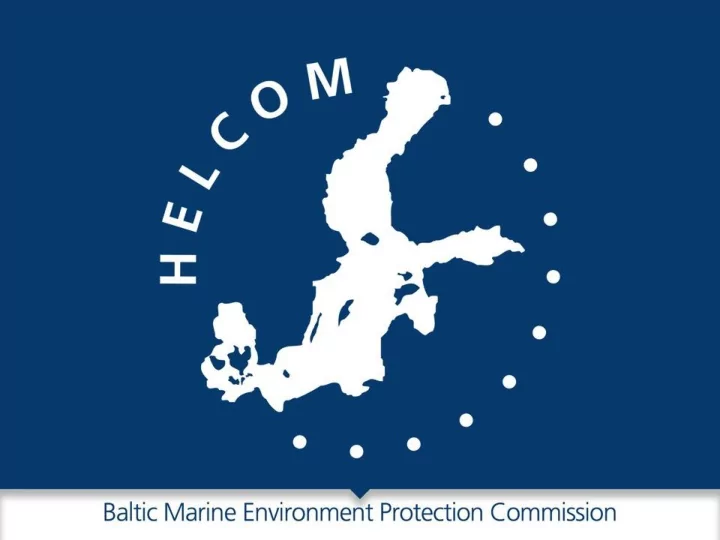

HELCOM Indicator Abundance and Distribution of Harbour porpoises – progress on Indicator assessment Sacha Viquerat (DE), Julia Carlström (SE), Olli Loisa (FI), Signe Sveegaard (DK) 10/5/2017 2
Abundance and Distribution of Harbour porpoises Abundance What is needed? • Establish GES definitions, initially directional trends (relative or absolute), but work towards absolute threshold values • Abundance estimates per population, for assessments per HELCOM sub-basin Distribution What is needed? • Establish GES definitions in relation to prevailing conditions • Information on distribution as well as seasonal changes between sub-basins and populations Viquerat, Carlström, 10/5/2017 Loisa, Sveegaard 3
Assessment units TWO POPULATIONS Viquerat, Carlström, 10/5/2017 4 Loisa, Sveegaard
Data availability – Belt Sea population Survey Year Source SCANS 1994 Hammond et al. 2005 SCANS II 2005 Hammond et al. 2013 Mini-SCANS 2012 Viquerat et al. 2014 SCANS 3 2016 Hammond et al. 2017 Belt Sea 2019 - Survey … Regular national monitoring scheme since 2002 in Germany (red dashed area), continuing at least through 2021. Danish telemetry data (all year) Acoustic monitoring data (all year) Viquerat, Carlström, 10/5/2017 Loisa, Sveegaard 5
Data analyses – Belt Sea population • Varying coverage between surveys renders immediate usage of raw results (i.e. block estimates) unsuitable • Modelling of data (see Gilles et al. 2016, currently in progress for SCANS II, Mini- SCANS and SCANS3) will allow population specific (see Sveegaard et al. 2015) and HELCOM sub-basin specific abundance estimates Light blue = compared areas, i.e. different! Viquerat, Carlström, 10/5/2017 Loisa, Sveegaard 6
Data availability – Baltic proper • Only reliable source for abundance and overall distribution is SAMBAH • Dire need for a follow up project (‘SAMBAH II’) to align with efforts undertaken to monitor the Belt Sea population • National acoustic monitoring programmes in several countries, need for international coordination Viquerat, Carlström, 10/5/2017 Loisa, Sveegaard 7
Summary and next steps for GES assessment – Abundance Belt Sea population • Currently not sufficient data for sophisticated trend estimation When SCANS data are fully available, re-model trend data within the population distribution range only, for evaluation on HELCOM sub-basin level Baltic Proper population • Only one assessment available. Despite lack of threshold value this abundance is clearly not GES Trend estimation to be done once more data points are available Further development Develop a demographic model to determine abundance threshold for a self sustainable harbour porpoise population Viquerat, Carlström, 10/5/2017 Loisa, Sveegaard 8
Summary and next steps for GES assessment – Distribution Belt Sea population • All-year distribution pattern quite well known from telemetry studies, primarily summer distribution known from surveys Develop habitat suitability models in combination with corridor analysis to assess the volume of animals that cross through the highly sensitive bottleneck passages (between Kattegat and German EEZ) and identify potential threats Baltic Proper population • Two years’ distribution pattern known from SAMBAH • Analyses on spatio-temporal foraging behaviour are currently being carried out Collate historical data on spatio-temporal occurrence as a starting point for evaluation of distribution range in relation to prevailing conditions Further analyses on spatio-temporal habitat use is needed Viquerat, Carlström, 10/5/2017 Loisa, Sveegaard 9
Data needs for improved GES assessment – Abundance and distribution Belt Sea population • Continued monitoring (visual and acoustic) and further telemetry studies to collect additional data points on population abundance and further knowledge on spatio- temporal distribution patterns Baltic Proper population • Serious need for SAMBAH II and coordinated national acoustic monitoring Both populations • Further genetic analyses for improved knowledge on spatio-temporal distribution patterns, especially in the southern Baltic Sea • Demographic data to estimate viable population sizes (incl. death rates, birth rates etc.) Viquerat, Carlström, 10/5/2017 Loisa, Sveegaard 10
References Gilles, A., Viquerat, S., Becker, E. A., Forney, K. A., Geelhoed, S. C. V., Haelters, J., . . . Aarts, G. (2016). Seasonal habitat- based density models for a marine top predator, the harbor porpoise, in a dynamic environment. Ecosphere, 7 (6), e01367. doi:10.1002/ecs2.1367 Hammond, P.S., Berggren, P., Benke, H., Borchers, D.L., Collet, A., Heide-Jørgensen, M.P., Heimlich, S., Hiby, A.R., Leopold, M.F. and Øien, N. (2002), Abundance of harbour porpoise and other cetaceans in the North Sea and adjacent waters. Journal of Applied Ecology, 39: 361 – 376. doi:10.1046/j.1365-2664.2002.00713.x Hammond, P. S., Macleod, K., Berggren, P., Borchers, D. L., Burt, L., Cañadas, A., . . . Vázquez, J. A. (2013). Cetacean abundance and distribution in European Atlantic shelf waters to inform conservation and management. Biological Conservation, 164 , 107-122. doi:10.1016/j.biocon.2013.04.010 Hammond, P. S., Lacey, C., Gilles, A., Viquerat, S., Börjesson, P., Herr, H., . . . Øien, N. (2017). Estimates of cetacean abundance in European Atlantic waters in summer 2016 from the SCANS-III aerial and shipboard surveys. ASCOBANS Report Peschko, V., Ronnenberg, K., Siebert, U., & Gilles, A. (2016). Trends of harbour porpoise ( Phocoena phocoena ) density in the southern North Sea. Ecological Indicators, 60 , 174-183. doi:10.1016/j.ecolind.2015.06.030 Sveegaard, S., Galatius, A., Dietz, R., Kyhn, L., Koblitz, J. C., Amundin, M., . . . Teilmann, J. (2015). Defining management units for cetaceans by combining genetics, morphology, acoustics and satellite tracking. Global Ecology and Conservation, 3 , 839-850. doi:10.1016/j.gecco.2015.04.002 Viquerat, S., Herr, H., Gilles, A., Peschko, V., Siebert, U., Sveegaard, S., & Teilmann, J. (2014). Abundance of harbour porpoises (Phocoena phocoena) in the western Baltic, Belt Seas and Kattegat. Marine Biology, 161(4), 745-754. doi:10.1007/s00227-013-2374-6 Viquerat, Carlström, 10/5/2017 Loisa, Sveegaard 11
Recommend
More recommend